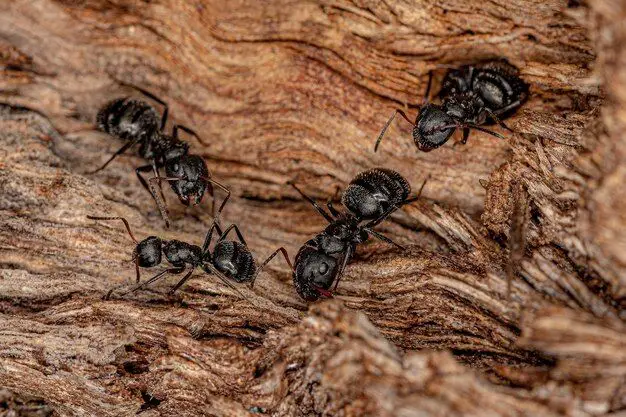Carpenter ants can be either black or brown in color. The most common species found in homes are the black carpenter ant (Camponotus pennsylvanicus) and the brown carpenter ant (Camponotus castaneus). Here is a quick overview of their identifying features:
Page Contents
Black Carpenter Ants
Black carpenter ants are glossy black in color. They have a single node between their thorax and abdomen giving them a pinched waist appearance. Their antennae have 12 segments. Black carpenter ants range in size from 1/4 inch for minor workers up to 3/4 inch for major workers. The major workers are often mistaken for winged termites.
Brown Carpenter Ants
Brown carpenter ants can range in color from red to dark brown. They are often bi-colored with darker abdomens and reddish-brown thoraxes and heads. Brown carpenter ants also have a single node between their thorax and abdomen. Their antennae have 11 segments. Minor workers range from 1/4 – 1/2 inch while major workers can reach up to 5/8 inch long.
Identifying Features of Carpenter Ants
Here are some key identifying features shared by both black and brown carpenter ants:
- Elbowed antennae
- Constricted waist (single node)
- Polished, smooth appearance
- No stinger (ants do not sting)
Differences Between Carpenter Ants and Termites
Carpenter ants are sometimes confused with termites since both can cause damage to wood. Here are some ways to tell them apart:
| Carpenter Ants | Termites |
|---|---|
| Black, red, or brown in color | Uniformly pale yellow to brown |
| Constricted waist | Straight waist, no constriction |
| Hard, armor-like exoskeleton | Soft, pliable exoskeleton |
| Wings present on swarmers | No wings on workers |
| No visible bead-like waist between thorax and abdomen | Bead-like waist often visible between thorax and abdomen |
| Antennae elbowed | Antennae straight |
| Coarse, random tunneling in wood | Small mud shelter tubes attached to wood surfaces |
Carpenter Ant Colony Locations
Carpenter ants tunnel inside wood to form their nests. Common nesting locations include:
- Hollow areas of doors, window frames, wall voids
- Attics and eaves
- Under roof tiles or shingles
- Around hot water pipes and heaters
- Kitchen and bath areas due to moisture
- Hollow spaces in logs, stumps, trees
Carpenter ants prefer wet, damaged, or decaying wood. They do not actually eat wood, but hollow it out to make room for their colonies. Outdoors carpenter ants nest in trees, logs, landscaping timbers and wooden shakes or shingles.
Damage Caused by Carpenter Ants
Carpenter ants cause damage by excavating wood to expand their nests. Signs of an infestation include:
- Hollowed areas and galleries chewed into wood surfaces
- Piles of coarse sawdust near nest sites
- Tunneled areas may make a tapping noise when touched due to hollowness
- Mud shelter tubes built outdoors along edges of buildings
- Ants seen crawling in lines along walls, floors, etc.
Carpenter ants prefer to nest in wood that is damp or contains moisture. They can accelerate damage by allowing moisture to penetrate deeper into wood structures. If left unchecked, carpenter ant damage can become severe and require replacement of wooden structural elements.
How to Get Rid of Carpenter Ants
To control carpenter ants:
- Inspect thoroughly to locate nest sites. Follow ants and look for hollow sounding areas.
- Seal cracks, repair leaks and eliminate moisture sources. This helps discourage nesting.
- Apply insecticidal baits near ant trails and nest sites.
- Use liquid treatments or dusts in wall voids and secluded nest areas.
- Remove and replace severely damaged wood.
- Trim trees and limbs touching structure to discourage ants from accessing the building.
- Prevent ants from trailing into home with sticky barrier products.
Getting rid of carpenter ants can take time but is important to prevent further structural damage. Preventative pest control measures such as sealing cracks and eliminating wood moisture also help avoid future carpenter ant infestations.
Conclusion
Carpenter ants are large, black or red-brown ants that excavate wood to form nest galleries. Their presence is indicated by coarse sawdust piles near damaged wood. While carpenter ants don’t consume wood, they can severely damage void areas, walls, and structural timbers. Stopping carpenter ants quickly helps prevent costly structural repairs. Effective control relies on locating and treating nests, removing damaged wood, and improving the building envelope to deny ant access.
